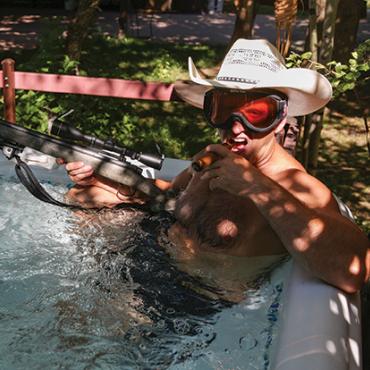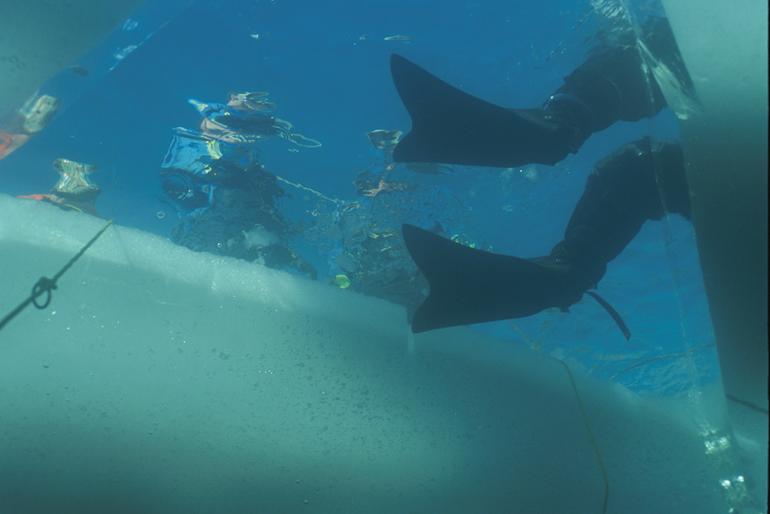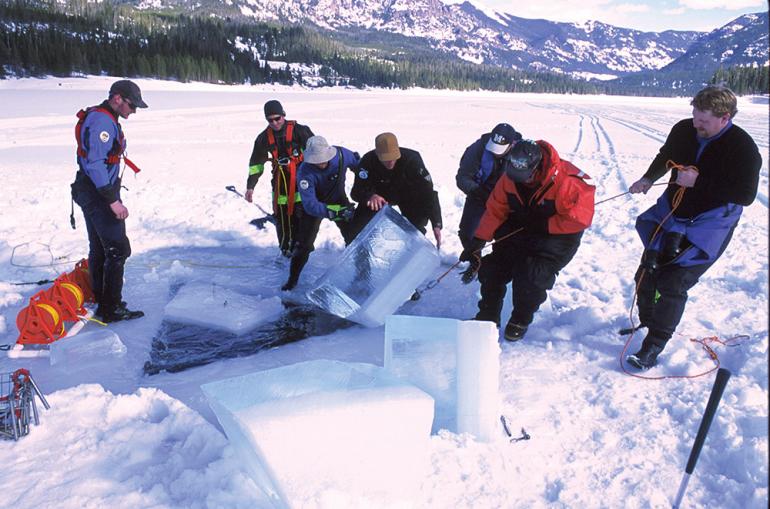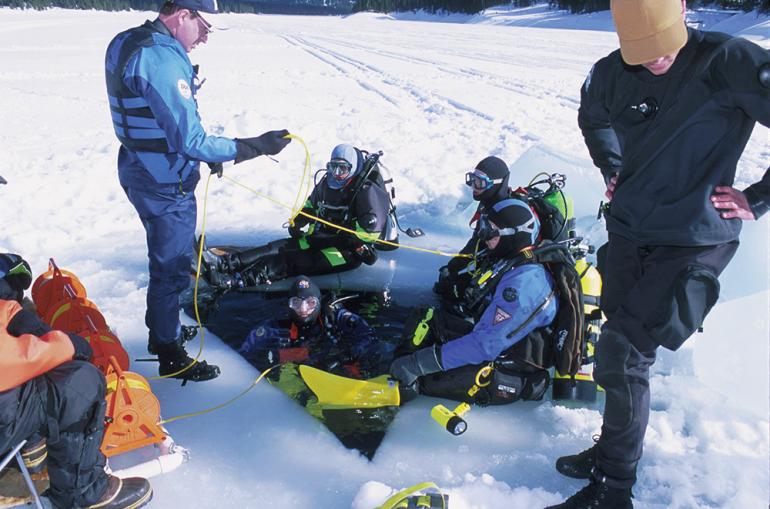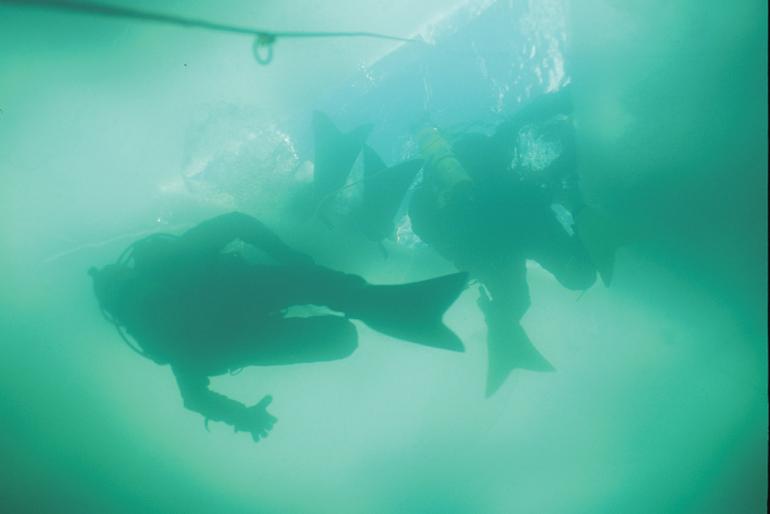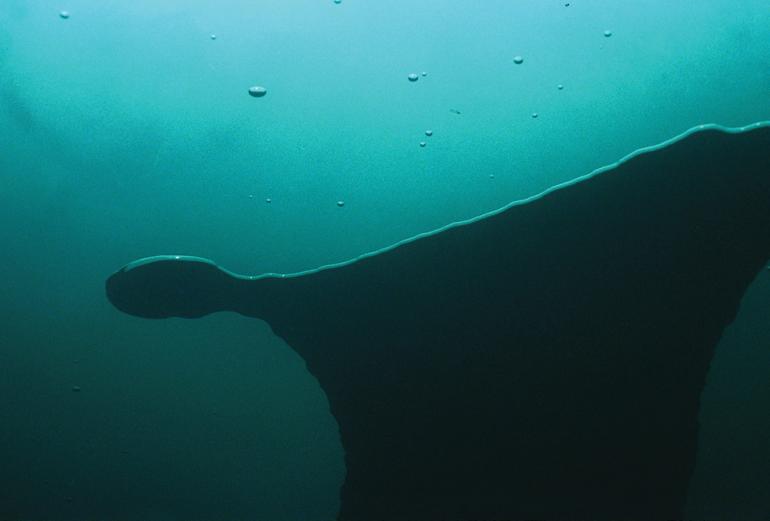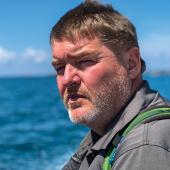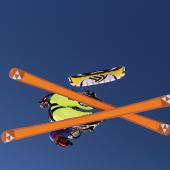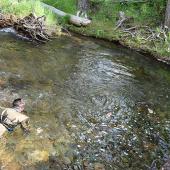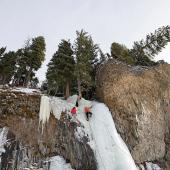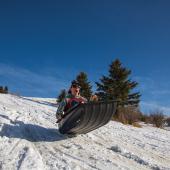Dancing on Ice
For a moment, a brief, dark, terrifying moment, I am trapped under ice.
My breathing accelerates, my heart pounds, every muscle in my body goes rigid. The blood roars through my veins like a river undammed. I’m looking upward at a vast, impenetrable sheet of bluish-white; but I see nothing, feel nothing. There is only a paralyzing coldness; a deep, intense, overwhelming sense of dread.
Then it’s gone, as quickly as it came; my mind returns to me and my body relaxes. I feel the bone-chilling water around my head and neck, and a dull sensation at the ends of my arms: my hands have gone numb.
The water in Hyalite Reservoir in February hovers around thirty-three degrees, which is not good for the extremities. I think about this, about the cold and my fear, and I laugh, spitting huge air bubbles out into the water. I watch them float to the surface and collide with the ice. They wobble and slide before settling in sprawling gray blobs. I think about the air tank on my back, the dry suit protecting most of my body, the thick neoprene around my head and hands, and the heavy nylon cord tied to my waist. Even if I were to run out of air or lose sight of the hole, the guys up above, decked out in full dive gear for a quick rescue, would haul me out in a matter of seconds. I’ve been underwater with a scuba tank on my back dozens of times. So why freak out? What’s the problem?
The problem is that huge sheet of ice is above my head, two feet thick and covering the entire lake save a tiny hole we carved out with a chain saw, a six-foot triangle barely large enough to hold a body. I can just barely make it out now; I’m down to forty feet and its shape is distorting, now fading, now gone entirely. I’m adrift in the green darkness; I’ve lost my sole window into the world above. All I can see is my yellow cord snaking upward, drifting out of sight like a treetop lost in the morning fog.
Or maybe the problem is that being deep underwater is so unnatural, so foreign, that no matter how many times I do it, there is always an instinctual revolt against such an asinine activity — that primordial tug of self-preservation clawing its way through the intellect, past all powers of reason, through all my human learning and into the core of my animal body, until finally it is just a feeling, a painful, overwhelming, and completely unacceptable feeling. I have no gills or blowhole; on the surface is where I belong, not underwater. So my body revolts, and I apply my mind to suppress the revolution.
Either way, I’m not nervous anymore; my mind has prevailed, and I’m here to enjoy the sub-surface sights of Hyalite Reservoir, to ply the depths of this underwater world, not question my reactions and justify the existence of human fear. Besides, I think I’ve earned the right to be a little unnerved. It’s the middle of winter, just about every body of water in the state is frozen over, there’s four feet of snow on the ground — and I’m scuba diving. But I’m calm and content and my dive buddy and I are cruising languidly just a few feet off the bottom. Looking up, we see our beaming halo, that 300-foot ring around the hole that we shoveled off so light could get through. It almost radiates, bright and clear like an enormous circle of blue amid an overcast sky. With such a prominent navigation aid, we know we can find the hole easily. There’s nothing to worry about.
We cruise awhile, our breathing slow and easy, first passing a refrigerator-sized rock, then floating along a steep drop-off. The terrain is almost lunar: rocky and barren, painted in shades of brown and gray and black. We look around for trout, but see none; perhaps they've detected us and taken refuge over the drop-off. My head and hands are a dull, barely perceptible ache now; I can shut out the discomfort entirely. Flipping over and swimming on my back for awhile, I gaze up at the halo and the light streaming in and occasionally I can just make out the triangular frame of the hole. It is like nothing I have ever seen, this ice-covered world; it looks as if the earth itself has been encased in a dome of frozen, immoveable clouds.
It is silent, and it is still. Not a bit of movement, anywhere. It reminds me of my very first dive, that first wonderful and exciting and utterly peaceful experience of breathing underwater, floating through the watery ether, free and serene in my effortless movements, like a hawk soaring on air currents or a maple leaf riding the autumn breeze. Scuba diving is always quiet; but this amazing stillness overwhelms me. This must be what space is like: quiet, tranquil, empty — and absolutely exhilarating.
My buddy gives the signal, and we ascend to the ice. We’re a long way from the hole, and though we can’t see it now, we know it’s there, just a few fin-kicks away. And so we play. We watch our bubbles rise and slap the ice, sliding frictionless across its slick undersurface, desperately seeking an exit, following every rivulet and crevasse. In places, it pools up in enormous silvery masses. We poke them with our hands, splitting them into a hundred little globules, then bead by bead they join together again. It reminds me of playing with the mercury from a broken thermometer, except now we’ve got gallons and gallons of the stuff. We could play with it all day.
Instead, we flip over, inflate our vests, and let the air suck us up against the ice in a kind of reverse gravity. Now upside down, we walk around, taking awkward steps, trying to get our balance. We pull out a golf club and a golf ball and we take turns golfing a few holes across the ice. We skate, we shuffle, we dance like teenagers, goofy and uninhibited. What a strange feeling this is, upside down in the water, dancing across the ice as if it’s the ground, as if our whole world has been inverted and all the natural forces of the earth are just a little confused by it all.
Our tanks are running low, so we flip back over and head toward the hole. As we near it, the light comes streaming down in shifting, sparkling rays. We pop up out of the water and look around us at the snow-covered Hyalite Range, the deep-green trees upholstering the slopes, and our friends looking down at us, smiling. We return the smiles with our big blue lips as they grab us and haul us out of the water. We keep smiling as we rip off our gear and sprint for the warming hut. As the blood returns to our heads and hands, as the shivering subsides, we stop jumping up and down and we begin to relax. My buddy turns to me and says, almost in a whisper, as if it’s a secret, some kind of verbal treasure: Nice dive. I rub my hands together over the propane heater and nod a fervent assent. And then we step out of the hut into the brisk winter air, we put all our gear back on and we help our friends into the water. And while we tend their safety lines, we imagine what they’re doing, what they’re seeing, what they’re feeling—and we start thinking about our next turn, about plunging into the frigid water, inverting our bulky, gear-draped bodies, and dancing across the ice.
Mike England has dived in many strange places, from Tanzania to Tasmania, but this is by far his weirdest underwater adventure. Mike is editor and publisher of Outside Bozeman.

